Using Social Media and Multi-Source Geospatial Data for Quantifying and Understanding Visitor’s Preferences in Rural Forest Scenes: A Case Study from Nanjing
Abstract
:1. Introduction
- Lack of cost-effective methods for acquiring, processing, and analyzing visitor-related data to describe the content of visitors’ feedback comprehensively;
- Lack of in-depth exploration of the effects of various factors in the rural forest scenes on visitors’ preferences in addition to natural factors.
2. Materials and Methods
2.1. Study Area and Research Framework
- Which rural forest scenes do visitors prefer?
- What are the characteristics of these rural forest scenes preferred by visitors?
- How are other factors of the rural forest scenes in addition to natural factors distributed?
- How can factors of rural forest scenes explain visitors’ preferences?
2.2. Data Collection and Preprocessing
2.2.1. Acquisition of Social Media Data
2.2.2. Screening of Social Media Data
- Photos in which visitors clearly expressed negative comments in their comments were excluded;
- Photos with single subjects, such as people, plants, animals, food, signs, etc., and those that reflect the indoor scene were excluded;
- Other photos that are unrelated to the content of the current rural forest scenes or fail to identify the specific geographical location were accurately excluded.
2.2.3. Acquisition of Muti-Source Geospatial Data
- Map service provider data: POIs were fetched from Bigemap, a widely used map service provider in China, and street networks were fetched from OSM. All these data were supplemented with on-site observation. After applying the correction algorithm to correct the data to the WGS-84 coordinate system and project it to the World Mercator system, their accuracy could meet the research needs.
- UAV remote sensing data: The UAV (DJI Mavic Air 2) was conducted at low altitudes (100 m flight height above the ground) with −90° of gimbal tilt angle, guaranteeing high spatial resolution [36] and mapping accuracy [37]. The time of the aerial survey was 29 April 2023, and there was sufficient daylight, 20 km/h wind speed at the site, and no electromagnetic interference in the surrounding environment to meet the requirements of UAV remote sensing. The study site was photographed in a “zigzag” pattern, and the overlap between horizontal and vertical pixels of each image was guaranteed to be more than 1/3 so that a Digital Orthophoto Map (DOM) of the village could be obtained using Pix4Dmapper (Version 4.4.12) software.
2.2.4. Factors of Rural Forest Scene Extraction
- Extraction of socio-economic factors from POIs: For fully utilizing relatively high accuracy positioning and multilevel categories [38] of POIs, all POIs were classified into consumption and non-consumptions (Table 1). Each of these categories of POIs was geo-processed by the KDE in ArcGIS (same as for visualizing visitor preferences), and the results separately reflected the socio-economic factor.
- Extraction of spatial factors from street networks: Street network data obtained from OSM were amended and supplemented according to the fine-scaled DOM obtained from UAV to fix errors in the OSM, in which the deviating street network was deleted, and the missing street network was added manually. Space syntax tools were applied to extract spatial factors by calculating configurative spatial relationships of street networks [39]. In this study, the segment model of space syntax was chosen to describe the networks quantitatively, and both angular and metric parameters were analyzed, including Connectivity, Integration, and Choice [40] (Table 1).
- Extraction of natural factors from UVA: The Normalized Difference Vegetation Index (NDVI) (Table 1) quantifies vegetation by measuring the difference between near-infrared light (which vegetation strongly reflects) and red light (which vegetation absorbs) [41], which was selected to represent the natural factor of rural forest scenes Taking advantage of the contrast of the characteristics of two bands from the DOM obtained by UVA, we utilized the Arithmetic function in ArcGIS to get the NDVI of the village. The NDVI equation [42] is as follows:where NIR is the pixel values from the near-infrared band, and Red is the pixel values from the red band.
2.3. Quantification and Modeling
2.3.1. Identifying the Visitor-Preferred Scenes
2.3.2. Semantic Segmentation and Cluster Analysis of Photos
- Semantic segmentation (Figure 4): Pixels of physical features of the screened photos were extracted using the Pyramid Scene Parsing Network (PSPNet) [44] model, which could accurately parse the scenes with complicated elements. In this study, PSPNet model training was based on the ADE20K dataset [45].
- Cluster analysis: We introduced the K-means clustering algorithm to perform dimensionality reduction. The K-means algorithm minimizes the within-cluster sum of squares [46]. One of these clusters is a collection of individuals with similarities, with obvious dissimilarities among different clusters. With the help of the K-means algorithm in IBM SPSS Statistics, we could categorize the visitor-preferred scenes according to their physical features obtained from semantic segmentation and find different types of visitor-preferred rural forest scenes that share similar features proportion, which exhibit significant differences.
2.3.3. Natural Language Processing on Comments
- Data cleaning: Before analysis, cleaning comments data should be performed appropriately, including removing special characters, punctuation marks, and deactivated words and performing operations such as word separation.
- Topic modeling: The Latent Dirichlet Allocation-based Natural Language Processing (LDA-NLP), a semantic extraction approach, was utilized to extract the comments topic according to different ratings. LDA-NLP helped to decompose the comments into various topics and determine the distribution of each document on each topic. By referring to the perplexity score, we can determine the number of topics to be extracted. A lower perplexity score indicates better generalization performance. For a test set of M documents, the perplexity is as follows:where refers to the probability of occurrence of each word in the test set.
- Sentiment analysis: After topic modeling, each topic contained a certain amount of topic words. Then, we categorized topic words into positive, neutral, and negative sentiments, and the visitor’s attitudes towards the topics were uncovered by counting the number of topic words under different categories.
2.3.4. Geodectector Analysis
- The factor detector [47] q-statistic measures the degree of spatial stratified heterogeneity of a Y if Y is stratified by itself and the determinant power of an explanatory variable (Xn) on Y if Y is stratified by Xn;
- The interaction detector [47] reveals whether the risk factors X1 and X2 (and more) have an interactive influence on Y. The format of the results for the interaction detector has five intervals, and the interaction relationship is determined using the location of q(x∩y) in the five intervals (Table 2).
3. Results
3.1. Result of Identifying the Visitor-Preferred Scenes
3.2. Result of Semantic Segmentation and Cluster Analysis of Photos
3.3. Result of Natural Language Processing on Comments
3.4. Result of Factors of Rural Forest Scene Extraction
- Socio-economic factor: The total amount of POIs collected from Bigemap is 83, including 46 consumption POIs (of all restaurants, hotels, and stores) and 37 non-consumption POIs (of all facilities and attractions). As Figure 9 shows, the visualization results of the two types of POIs processed by KDE demonstrate a significant spatial variation: while high-service-level areas of consumption are concentrated on the west side of Huanglong Tea Street, high-service-level areas of non-consumption are mainly located in the eastern part of the village.
- Spatial factor: As previous research reported [49], there is a certain degree of collinearity between space syntax indicators (Table 5). The distribution of five spatial configuration indicators geo-processed by KED is depicted in Figure 9. The high-value areas of these five indicators, representing more convenient spatial configuration areas, are concentrated in the center of the village, especially the entrance. The result of these five indicators can explain spatial properties from diverse perspectives. Connectivity is relatively independent of the other indicators (Person coefficient < 0.3, Sig. < 0.01) (Table 5). The high value of connectivity, which represents how many spaces are directly connected to the starting space, is more dispersed in spatial distribution, and the areas with high connectivity are relatively small. NACH and NAIN are all significantly correlated with each other (Sig. < 0.01) (Table 5). NAIN and NACH, which represent visitors’ accessibility and usability, respectively, are significantly affected by the calculation radius (R). With a small radius (R = 200 m), the calculated values indicate local walking behavior (<5 min), and with an increase in the radius (R = 1000 m), the calculated values reflect approximately 15–20 min walk behavior [40].
- Natural factor: The final 175 site photos with a resolution of 4000 × 3000 pixels per image were captured by UAV. After being imported into Pix4Dmapper software, 170 out of 175 (97%) photos were calibrated, and 175 out of 175 (100%) images were geolocated to get the fine-scaled DOM of the village with the WGS-84 coordinate system. As Figure 9 shows, NDVI obtained from the band calculations of the DOM indicates the vegetation growth and cover status of Huanglongxian Village. The value of NDVI is scattered between 0 and 1, and the average NDVI value is closer to 1, which means that the vegetation growth (green leaf area) and vegetation cover of Huanglongxian Village are well-maintained overall. There is not much difference in greening level.
3.5. Result of Geodectector Analysis
4. Discussion
4.1. Comprehensively Description of Visitors’ Feedback
4.1.1. Spatial Distribution of Preferred Rural Forest Scenes
4.1.2. Scenes Characteristics of Preferred Rural Forest Scenes
- In the waterfront scene, the sky and the water are dominant, accompanied by trees along the shore of Huanglong Lake.
- The lawn scene is Huanglong Square, a great lawn covered by trample-resistant grass with sparse dwarf trees. The lawn scene gives visitors access to enjoy the sunshine and blue sky.
- Mainly referring to the Huanglong Tea Street and Xiaoxian Market, the street scene is visitors’ most popular type of rural forest scene in Huanglongxian Village. Wide and well-greened streets are flanked by antique buildings where visitors can see the sky.
- In the natural environment with plenty of trees, the second most popular scene is the woodland scene, with relatively less sky visibility, providing visitors with shade.
- In the enclosed scene, the physical features are scattered, among which the wall relatively occupies a higher proportion. For example, the scene inside the Huanglong Pavilion, enclosed by low walls, offers visitors a place to rest.
- In the architectural scene, the proportion of buildings is extremely high, which means the surroundings of native architecture with classical characteristics have a unique attraction for urban visitors.
4.1.3. Visitors’ Attitudes to Rural Forest Scenes
- Facilities support visitors and activities, including restrooms, farms, walking paths, etc. To some extent, tourism-related and consumption-related topic words can explain visitors’ preference for street scenes. Tea houses, shops, and restaurants are available in the street scene for rest, dining, and shopping.
- Nature-related topic words indicate visitors prefer fresh air, tea mountains, lakes, and bamboo forests in waterfront and woodland scenes. Lawn-related topics words illustrate that visitors prefer the lawn scene because it supports numerous activities and access to sharing time with family and friends.
- While the facilities and natural conditions of Huanglongxian Village already meet the needs of visitors and no additional construction is required, tea culture still needs to be optimized. Even though Huanglongxian Village is famous for the Jinling tea culture, its rural forest scenes lack elements that reflect the relevant culture, such as facilities, attractions, and services. This is why it fails to give tourists a good tea culture experience.
4.2. Effects of Factors in the Rural Forest Scenes on Visitors’ Preferences
4.2.1. Explanation Power of the Singe Factor in Rural Forest Scenes
4.2.2. Interactive Effect of Factors in Rural Forest Scenes
4.3. Theoretical Implications
4.4. Practical Implications
4.5. Limitations
5. Conclusions
Author Contributions
Funding
Data Availability Statement
Acknowledgments
Conflicts of Interest
References
- Zhang, F.; Wang, N.; Li, Q. Low-Carbon Space in Urban and Rural Areas: Ecological Greenway Planning of Shanhaiguan District, Qinhuangdao City, China. Appl. Mech. Mater. 2013, 253–255, 821–824. [Google Scholar] [CrossRef]
- Lan, Y.; Liu, Q.; Zhu, Z. Exploring Landscape Design Intensity Effects on Visual Preferences and Eye Fixations in Urban Forests: Insights from Eye Tracking Technology. Forests 2023, 14, 1628. [Google Scholar] [CrossRef]
- Sun, Y.; Shao, Y.; Chan, E.H.W. Co-Visitation Network in Tourism-Driven Peri-Urban Area Based on Social Media Analytics: A Case Study in Shenzhen, China. Landsc. Urban Plan. 2020, 204, 103934. [Google Scholar] [CrossRef]
- Su, T.; Wang, K.; Li, S.; Wang, X.; Li, H.; Ding, H.; Chen, Y.; Liu, C.; Liu, M.; Zhang, Y. Analysis and Optimization of Landscape Preference Characteristics of Rural Public Space Based on Eye-Tracking Technology: The Case of Huangshandian Village, China. Sustainability 2022, 15, 212. [Google Scholar] [CrossRef]
- Kastenholz, E.; Eusebio, C.; Carneiro, M.J. Segmenting the Rural Tourist Market by Sustainable Travel Behaviour: Insights from Village Visitors in Portugal. J. Destin. Mark. Manag. 2018, 10, 132–142. [Google Scholar] [CrossRef]
- Gao, C.; Cheng, L.; Iqbal, J.; Cheng, D. An Integrated Rural Development Mode Based on a Tourism-Oriented Approach: Exploring the Beautiful Village Project in China. Sustainability 2019, 11, 3890. [Google Scholar] [CrossRef]
- Tu, S.; Long, H.; Zhang, Y.; Ge, D.; Qu, Y. Rural Restructuring at Village Level under Rapid Urbanization in Metropolitan Suburbs of China and Its Implications for Innovations in Land Use Policy. Habitat Int. 2018, 77, 143–152. [Google Scholar] [CrossRef]
- Arnberger, A.; Eder, R. Are Urban Visitors’ General Preferences for Green-Spaces Similar to Their Preferences When Seeking Stress Relief? Urban For. Urban Green. 2015, 14, 872–882. [Google Scholar] [CrossRef]
- Li, C.; Shen, S.; Ding, L. Evaluation of the Winter Landscape of the Plant Community of Urban Park Green Spaces Based on the Scenic Beauty Esitimation Method in Yangzhou, China. PLoS ONE 2020, 15, e0239849. [Google Scholar] [CrossRef]
- Santosa, H.; Ernawati, J.; Wulandari, L.D. Visual Quality Evaluation of Urban Commercial Streetscape for the Development of Landscape Visual Planning System in Provincial Street Corridors in Malang, Indonesia. IOP Conf. Ser. Earth Environ. Sci. 2018, 126, 012202. [Google Scholar] [CrossRef]
- Wilkins, E.J.; Van Berkel, D.; Zhang, H.; Dorning, M.A.; Beck, S.M.; Smith, J.W. Promises and Pitfalls of Using Computer Vision to Make Inferences about Landscape Preferences: Evidence from an Urban-Proximate Park System. Landsc. Urban Plan. 2022, 219, 104315. [Google Scholar] [CrossRef]
- Jay, M.; Schraml, U. Understanding the Role of Urban Forests for Migrants—Uses, Perception and Integrative Potential. Urban For. Urban Green. 2009, 8, 283–294. [Google Scholar] [CrossRef]
- Sonti, N.F.; Campbell, L.K.; Svendsen, E.S.; Johnson, M.L.; Novem Auyeung, D.S. Fear and Fascination: Use and Perceptions of New York City’s Forests, Wetlands, and Landscaped Park Areas. Urban For. Urban Green. 2020, 49, 126601. [Google Scholar] [CrossRef]
- Southon, G.E.; Jorgensen, A.; Dunnett, N.; Hoyle, H.; Evans, K.L. Biodiverse Perennial Meadows Have Aesthetic Value and Increase Residents’ Perceptions of Site Quality in Urban Green-Space. Landsc. Urban Plan. 2017, 158, 105–118. [Google Scholar] [CrossRef]
- Heyman, E. Analysing Recreational Values and Management Effects in an Urban Forest with the Visitor-Employed Photography Method. Urban For. Urban Green. 2012, 11, 267–277. [Google Scholar] [CrossRef]
- Du, H.; Jiang, H.; Song, X.; Zhan, D.; Bao, Z. Assessing the Visual Aesthetic Quality of Vegetation Landscape in Urban Green Space from a Visitor’s Perspective. J. Urban Plan. Dev. 2016, 142, 04016007. [Google Scholar] [CrossRef]
- Arnberger, A.; Budruk, M.; Schneider, I.E.; Wilhelm Stanis, S.A. Predicting Place Attachment among Walkers in the Urban Context: The Role of Dogs, Motivations, Satisfaction, Past Experience and Setting Development. Urban For. Urban Green. 2022, 70, 127531. [Google Scholar] [CrossRef]
- Xiang, Z.; Gretzel, U. Role of Social Media in Online Travel Information Search. Tour. Manag. 2010, 31, 179–188. [Google Scholar] [CrossRef]
- Huang, Y.; Li, Z.; Huang, Y. User Perception of Public Parks: A Pilot Study Integrating Spatial Social Media Data with Park Management in the City of Chicago. Land 2022, 11, 211. [Google Scholar] [CrossRef]
- Li, Q.; Wu, Y.; Wang, S.; Lin, M.; Feng, X.; Wang, H. VisTravel: Visualizing Tourism Network Opinion from the User Generated Content. J. Vis. 2016, 19, 489–502. [Google Scholar] [CrossRef]
- Chan, H.K.; Wang, X.; Lacka, E.; Zhang, M. A Mixed-Method Approach to Extracting the Value of Social Media Data. Prod. Oper. Manag. 2016, 25, 568–583. [Google Scholar] [CrossRef]
- Liu, T.-J.; Lin, Y.-C.; Lin, W.; Kuo, C.-C.J. Visual Quality Assessment: Recent Developments, Coding Applications and Future Trends. APSIPA Trans. Signal Inf. Process. 2013, 2, e4. [Google Scholar] [CrossRef]
- Mira, M.D.R.C.; Mónico, L.M.; Breda, Z.J. Territorial Dimension in the Internationalization of Tourism Destinations: Structuring Factors in the Post-COVID19. Tour. Manag. Stud. 2021, 17, 33–44. [Google Scholar] [CrossRef]
- Psyllidis, A.; Gao, S.; Hu, Y.; Kim, E.-K.; McKenzie, G.; Purves, R.; Yuan, M.; Andris, C. Points of Interest (POI): A Commentary on the State of the Art, Challenges, and Prospects for the Future. Comput. Urban Sci. 2022, 2, 20. [Google Scholar] [CrossRef] [PubMed]
- Chen, B.; Tu, Y.; Song, Y.; Theobald, D.M.; Zhang, T.; Ren, Z.; Li, X.; Yang, J.; Wang, J.; Wang, X.; et al. Mapping Essential Urban Land Use Categories with Open Big Data: Results for Five Metropolitan Areas in the United States of America. Isprs J. Photogramm. Remote Sens. 2021, 178, 203–218. [Google Scholar] [CrossRef]
- Ye, Y.; Richards, D.; Lu, Y.; Song, X.; Zhuang, Y.; Zeng, W.; Zhong, T. Measuring Daily Accessed Street Greenery: A Human-Scale Approach for Informing Better Urban Planning Practices. Landsc. Urban Plan. 2019, 191, 103434. [Google Scholar] [CrossRef]
- Kuliga, S.F.; Nelligan, B.; Dalton, R.C.; Marchette, S.; Shelton, A.L.; Carlson, L.; Hölscher, C. Exploring Individual Differences and Building Complexity in Wayfinding: The Case of the Seattle Central Library. Environ. Behav. 2019, 51, 622–665. [Google Scholar] [CrossRef]
- Hillier, B.; Iida, S. Network and Psychological Effects in Urban Movement. In Proceedings of the Spatial Information Theory, Ellicottville, NY, USA, 14–18 September 2005; Cohn, A.G., Mark, D.M., Eds.; Springer: Berlin, Heidelberg, 2005; pp. 475–490. [Google Scholar]
- Koohsari, M.J.; Kaczynski, A.T.; Mcormack, G.R.; Sugiyama, T. Using Space Syntax to Assess the Built Environment for Physical Activity: Applications to Research on Parks and Public Open Spaces. Leis. Sci. 2014, 36, 206–216. [Google Scholar] [CrossRef]
- Luo, J.; Zhao, T.; Cao, L.; Biljecki, F. Semantic Riverscapes: Perception and Evaluation of Linear Landscapes from Oblique Imagery Using Computer Vision. Landsc. Urban Plan. 2022, 228, 104569. [Google Scholar] [CrossRef]
- Albetis, J.; Duthoit, S.; Guttler, F.; Jacquin, A.; Goulard, M.; Poilvé, H.; Féret, J.-B.; Dedieu, G. Detection of Flavescence Dorée Grapevine Disease Using Unmanned Aerial Vehicle (UAV) Multispectral Imagery. Remote Sens. 2017, 9, 308. [Google Scholar] [CrossRef]
- Liu, C.; Cao, Y.; Yang, C.; Zhou, Y.; Ai, M. Pattern Identification and Analysis for the Traditional Village Using Low Altitude UAV-Borne Remote Sensing: Multifeatured Geospatial Data to Support Rural Landscape Investigation, Documentation and Management. J. Cult. Herit. 2020, 44, 185–195. [Google Scholar] [CrossRef]
- Donahue, M.L.; Keeler, B.L.; Wood, S.A.; Fisher, D.M.; Hamstead, Z.A.; McPhearson, T. Using Social Media to Understand Drivers of Urban Park Visitation in the Twin Cities, MN. Landsc. Urban Plan. 2018, 175, 1–10. [Google Scholar] [CrossRef]
- Liang, H.; Yan, Q.; Yan, Y.; Zhang, L.; Zhang, Q. Spatiotemporal Study of Park Sentiments at Metropolitan Scale Using Multiple Social Media Data. Land 2022, 11, 1497. [Google Scholar] [CrossRef]
- Kobayashi, M.; Takeda, K. Information Retrieval on the Web. ACM Comput. Surv. 2000, 32, 144–173. [Google Scholar] [CrossRef]
- Kedzierski, M.; Wierzbicki, D. Methodology of Improvement of Radiometric Quality of Images Acquired from Low Altitudes. Measurement 2016, 92, 70–78. [Google Scholar] [CrossRef]
- Cao, J.; Leng, W.; Liu, K.; Liu, L.; He, Z.; Zhu, Y. Object-Based Mangrove Species Classification Using Unmanned Aerial Vehicle Hyperspectral Images and Digital Surface Models. Remote Sens. 2018, 10, 89. [Google Scholar] [CrossRef]
- Shang, Y.; Wen, C.; Bai, Y.; Hou, D. A Novel Framework for Exploring the Spatial Characteristics of Leisure Tourism Using Multisource Data: A Case Study of Qingdao, China. IEEE J. Sel. Top. Appl. Earth Obs. Remote Sens. 2022, 15, 6259–6271. [Google Scholar] [CrossRef]
- Soares, I.; Yamu, C.; Weitkamp, G. The Relationship between the Spatial Configuration and the Fourth Sustainable Dimension Creativity in University Campuses: The Case Study of Zernike Campus, Groningen, The Netherlands. Sustainability 2020, 12, 9263. [Google Scholar] [CrossRef]
- Sheng, Q.; Wan, D.; Yu, B. Effect of Space Configurational Attributes on Social Interactions in Urban Parks. Sustainability 2021, 13, 7805. [Google Scholar] [CrossRef]
- Lyu, F.; Zhang, L. Using Multi-Source Big Data to Understand the Factors Affecting Urban Park Use in Wuhan. Urban For. Urban Green. 2019, 43, 126367. [Google Scholar] [CrossRef]
- Ersi, C.; Bayaer, T.; Bao, Y.; Bao, Y.; Yong, M.; Lai, Q.; Zhang, X.; Zhang, Y. Comparison of Phenological Parameters Extracted from SIF, NDVI and NIRv Data on the Mongolian Plateau. Remote Sens. 2023, 15, 187. [Google Scholar] [CrossRef]
- Silverman, B.W. Density Estimation for Statistics and Data Analysis; CRC Press: Boca Raton, FL, USA, 1986; ISBN 978-0-412-24620-3. [Google Scholar]
- Zhao, H.; Shi, J.; Qi, X.; Wang, X.; Jia, J. Pyramid Scene Parsing Network. In Proceedings of the 2017 IEEE Conference on Computer Vision and Pattern Recognition (CVPR), Honolulu, HI, USA, 21–26 July 2017; pp. 6230–6239. [Google Scholar]
- Zhou, B.; Zhao, H.; Puig, X.; Xiao, T.; Fidler, S.; Barriuso, A.; Torralba, A. Semantic Understanding of Scenes through the ADE20K Dataset. Int. J. Comput. Vis. 2019, 127, 302–321. [Google Scholar] [CrossRef]
- Hartigan, J.A.; Wong, M.A. Algorithm AS 136: A K-Means Clustering Algorithm. J. R. Stat. Soc. Ser. C Appl. Stat. 1979, 28, 100–108. [Google Scholar] [CrossRef]
- Wang, J.-F.; Zhang, T.-L.; Fu, B.-J. A Measure of Spatial Stratified Heterogeneity. Ecol. Indic. 2016, 67, 250–256. [Google Scholar] [CrossRef]
- Wang, J.; Li, X.; Christakos, G.; Liao, Y.; Zhang, T.; Gu, X.; Zheng, X. Geographical Detectors-Based Health Risk Assessment and Its Application in the Neural Tube Defects Study of the Heshun Region, China. Int. J. Geogr. Inf. Sci. 2010, 24, 107–127. [Google Scholar] [CrossRef]
- Zhai, Y.; Baran, P.K. Do Configurational Attributes Matter in Context of Urban Parks? Park Pathway Configurational Attributes and Senior Walking. Landsc. Urban Plan. 2016, 148, 188–202. [Google Scholar] [CrossRef]
- Tsou, M.-H. Research Challenges and Opportunities in Mapping Social Media and Big Data. Cartogr. Geogr. Inf. Sci. 2015, 42, 70–74. [Google Scholar] [CrossRef]
- Heikinheimo, V.; Tenkanen, H.; Bergroth, C.; Järv, O.; Hiippala, T.; Toivonen, T. Understanding the Use of Urban Green Spaces from User-Generated Geographic Information. Landsc. Urban Plan. 2020, 201, 103845. [Google Scholar] [CrossRef]
- Li, Q.; Li, S.; Zhang, S.; Hu, J.; Hu, J. A Review of Text Corpus-Based Tourism Big Data Mining. Appl. Sci. 2019, 9, 3300. [Google Scholar] [CrossRef]
- Padilla, J.J.; Kavak, H.; Lynch, C.J.; Gore, R.J.; Diallo, S.Y. Temporal and Spatiotemporal Investigation of Tourist Attraction Visit Sentiment on Twitter. PLoS ONE 2018, 13, e0198857. [Google Scholar] [CrossRef]
- Corcoran, P.; Mooney, P.; Bertolotto, M. Analysing the Growth of OpenStreetMap Networks. Spat. Stat. 2013, 3, 21–32. [Google Scholar] [CrossRef]
- Mashhadi, A.; Quattrone, G.; Capra, L. Putting Ubiquitous Crowd-Sourcing into Context. In Proceedings of the 2013 Conference on Computer Supported Cooperative Work, San Antonio, TX, USA, 23–27 February 2013; Association for Computing Machinery: New York, NY, USA, 2013; pp. 611–622. [Google Scholar]
- Goodchild, M.F. Citizens as Sensors: The World of Volunteered Geography. Geo. J. 2007, 69, 211–221. [Google Scholar] [CrossRef]
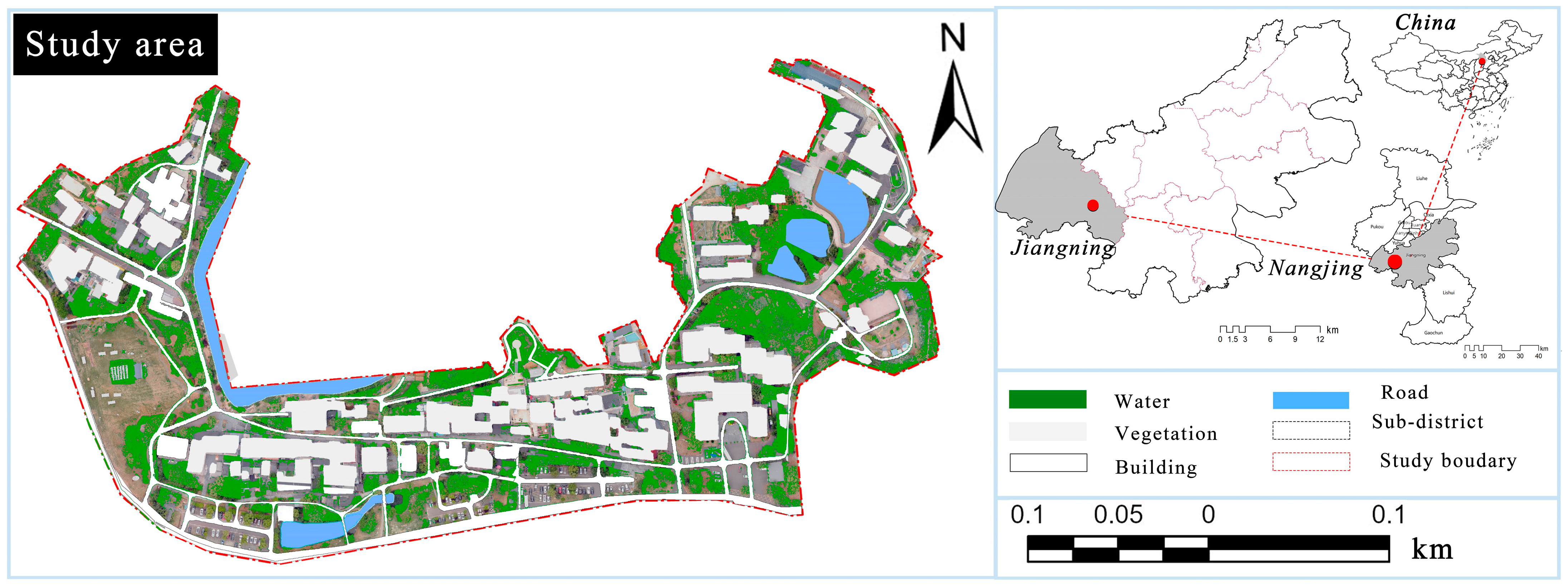
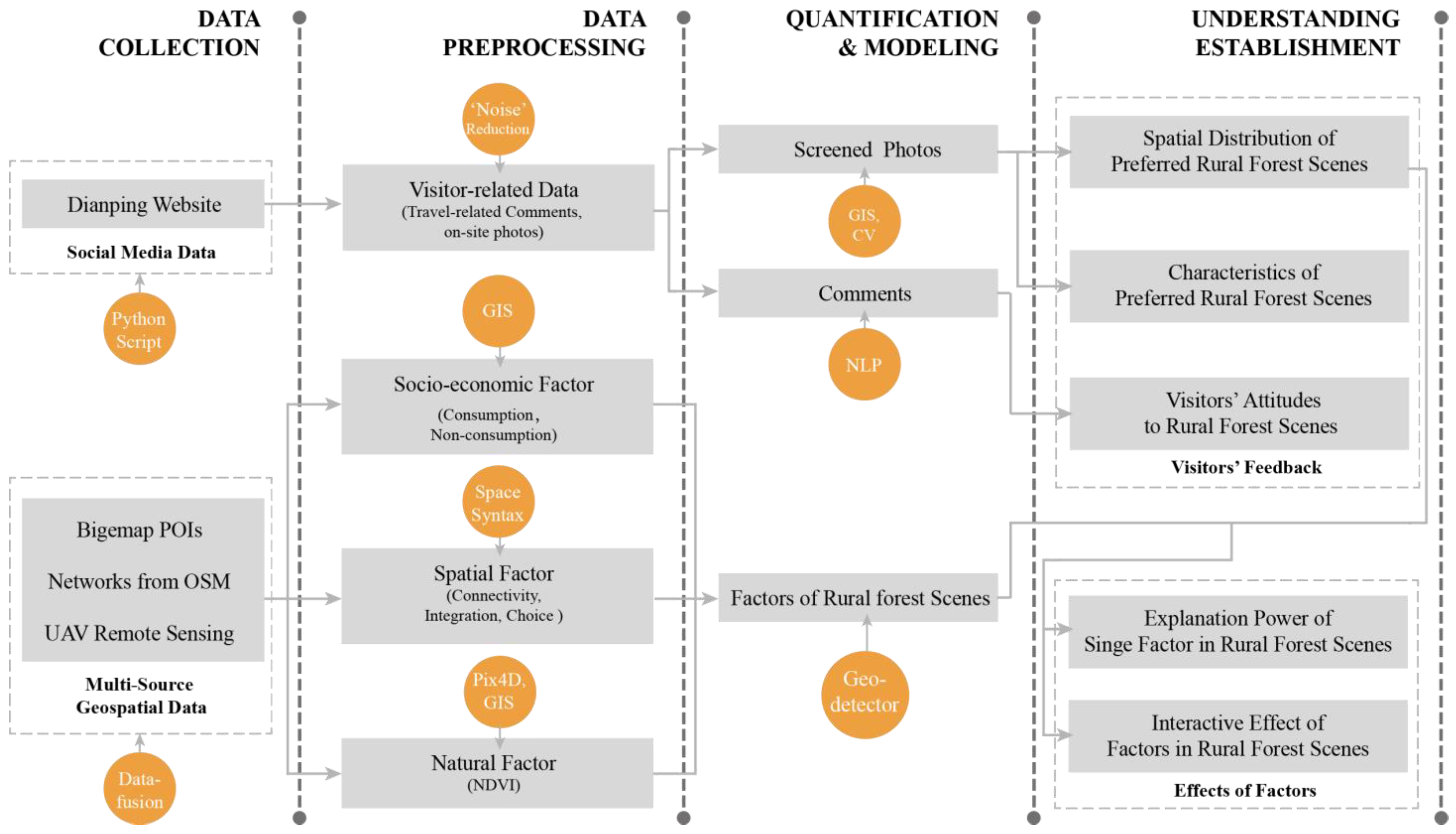
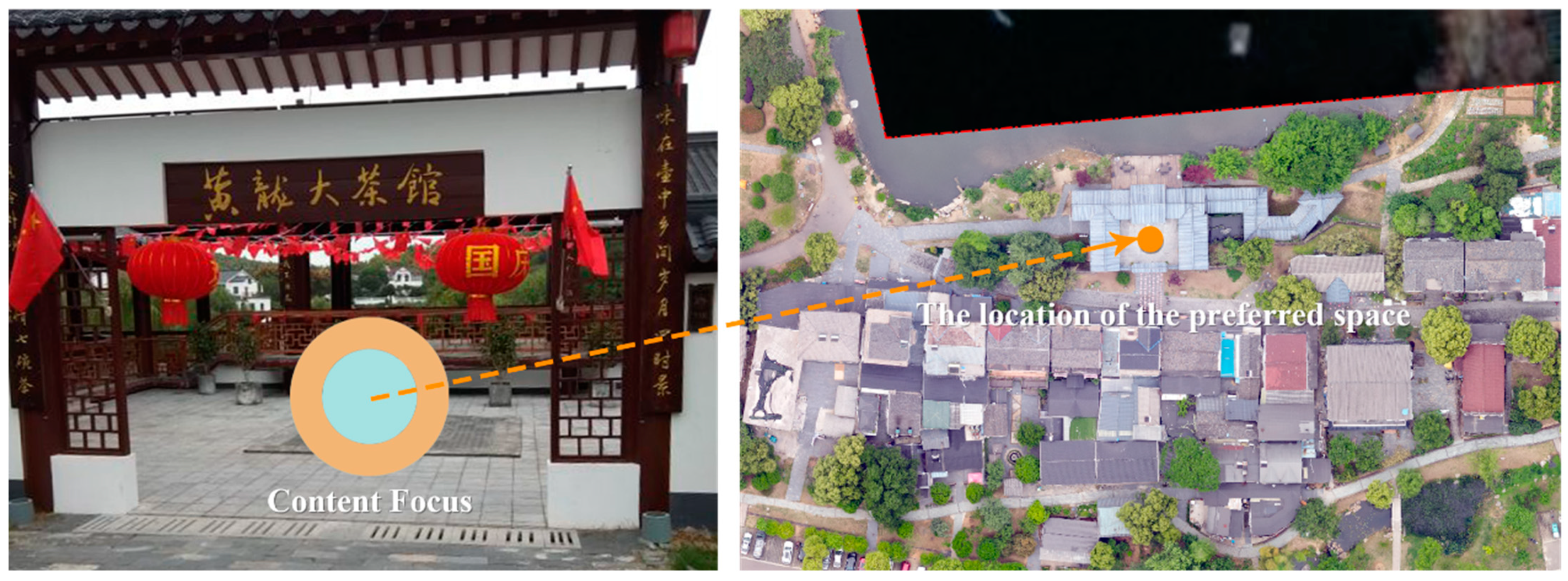
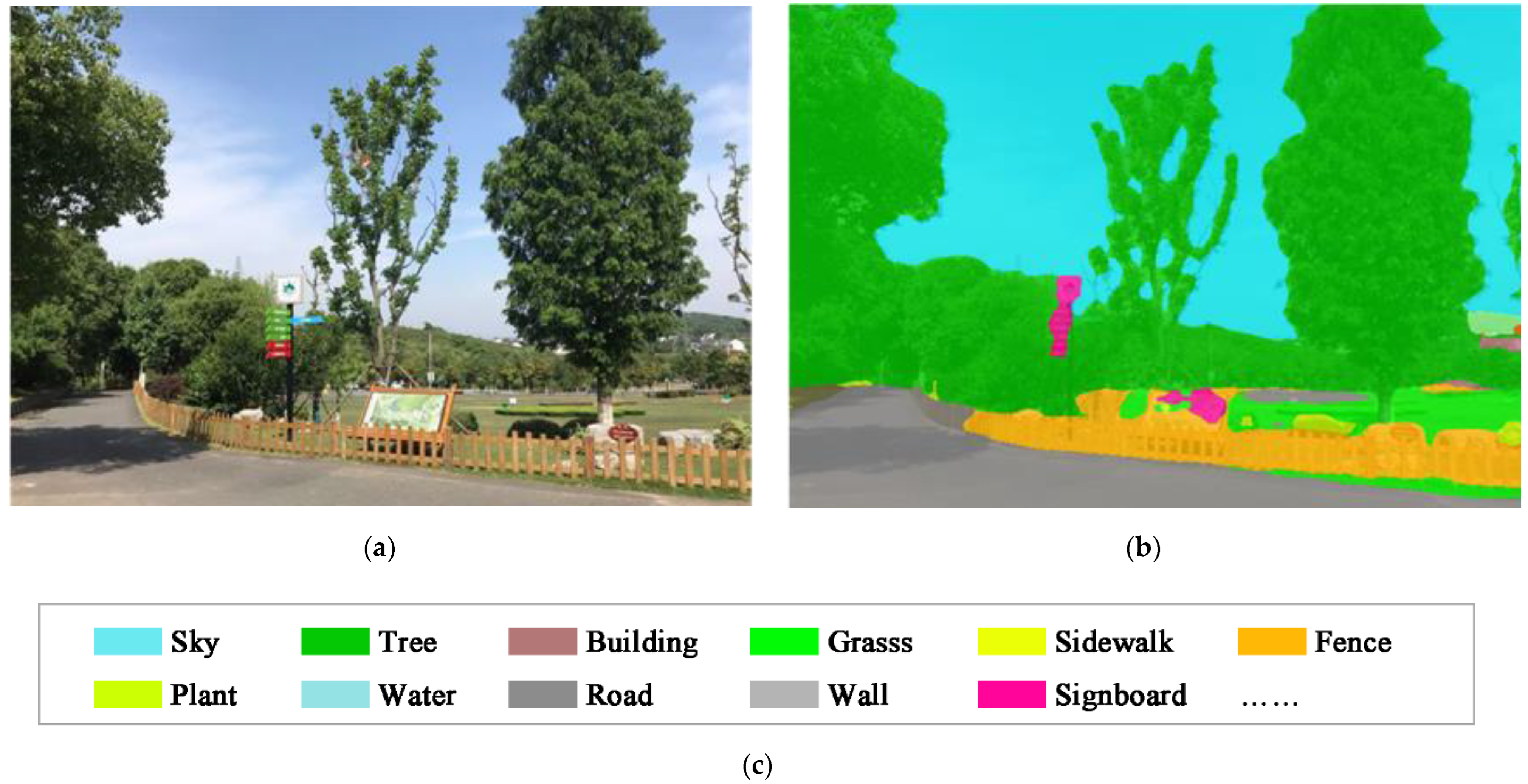



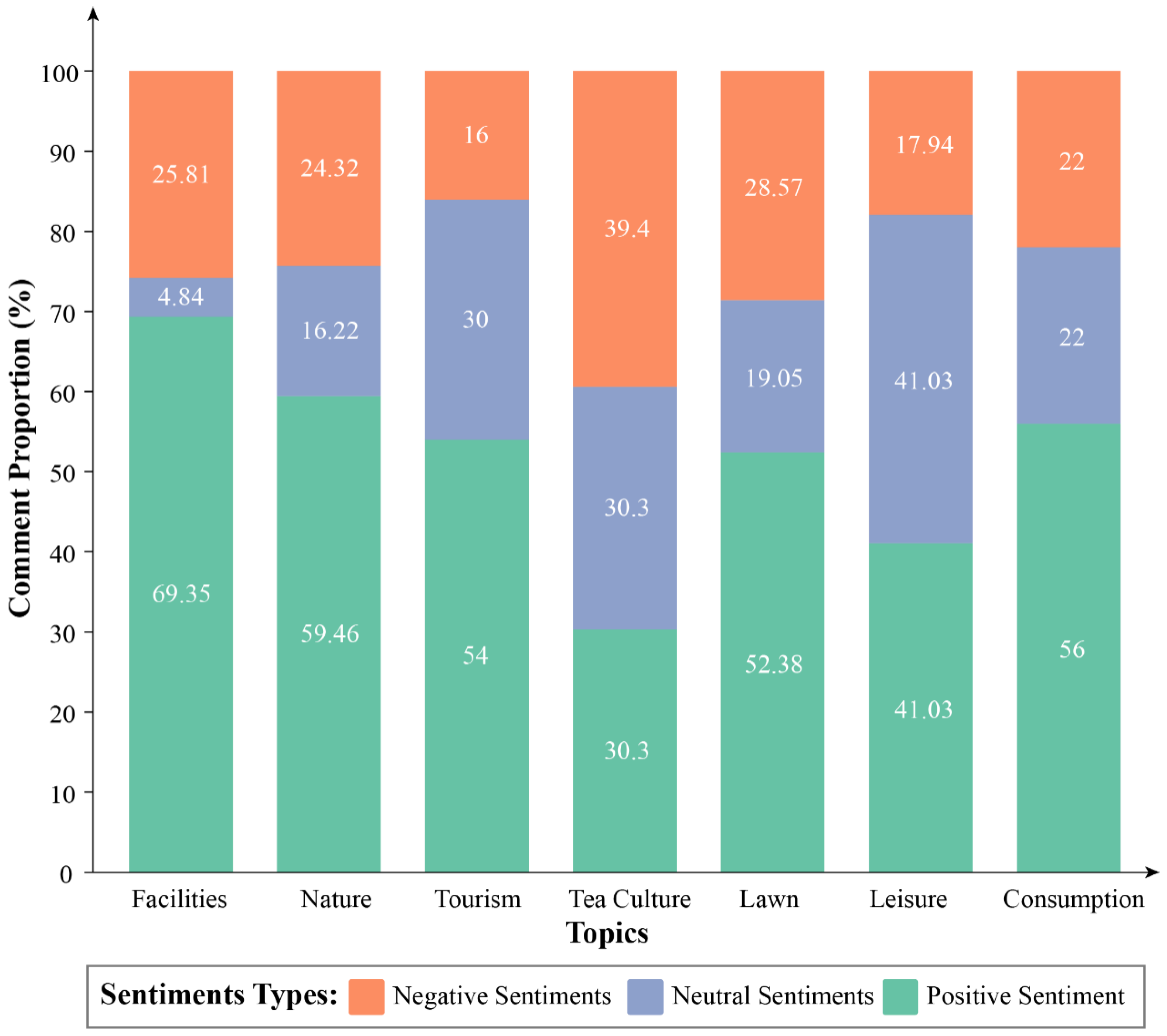
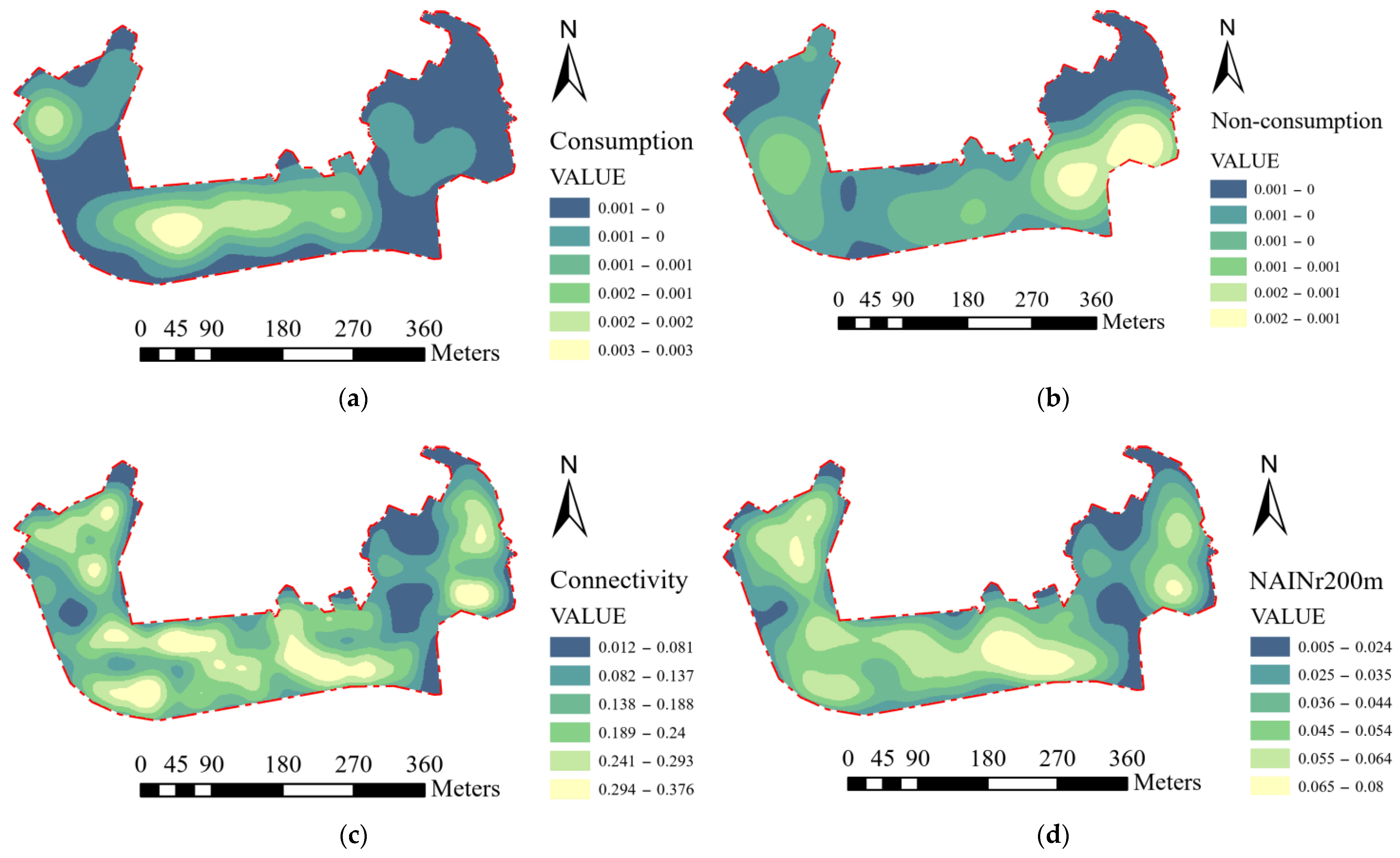

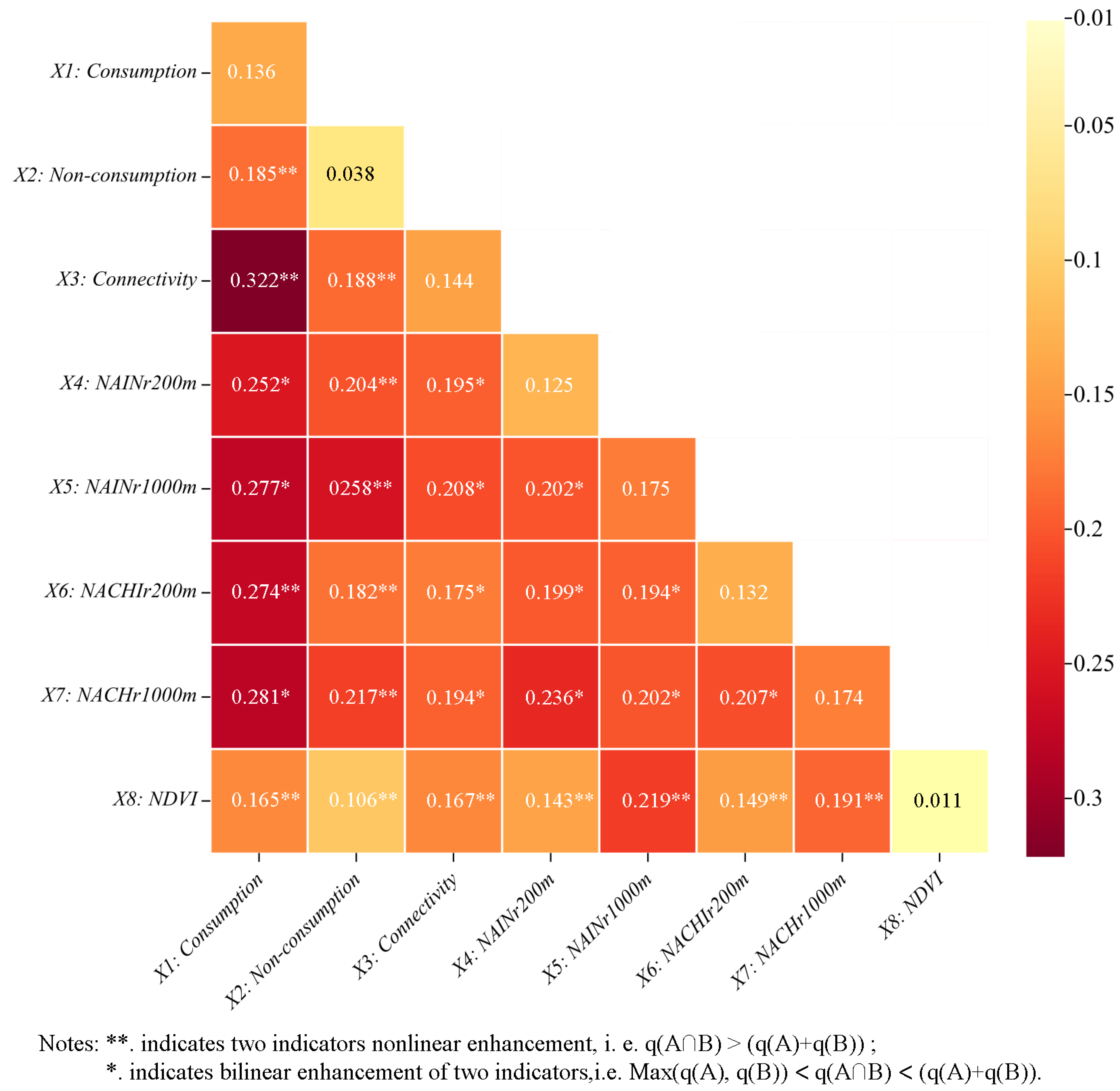
| Variables | Data Source | Description | Reference | ||
|---|---|---|---|---|---|
| Explained Variable (Y) | |||||
| Y: Visitor Preference | Dianping | Based on systematic observation, we identified the location of the visitor preference scenes from photos posted by visitors on Dianping.com. These location points were geo-processed by KDE, and the result of data smoothing represented the Visitor Preference. | Yiwei Huang et al. [19] Silverman et al. [43] | ||
| Explanatory Variables (X) | |||||
| Socio-economic factor | |||||
| X1: Consumption | Bigemap | The density of POIs, including all restaurants, hostels, and stores, represents the service level of consumption for visitors. | Yiqun Shang et al. [38] | ||
| X2: Non-consumption | Bigemap | The density of POIs, including all facilities and attractions, represents the service level of non-consumption for visitors. | |||
| Spatial factor | |||||
| X3: Connectivity | OSM, UAV | Connectivity represents how many spaces are directly connected to the starting space. The angular connectivity offers a better description of space relationships by considering the weight of each connected space according to the turn angle. | Isabelle Soares et al. [39] Cha Ersi et al. [42] | ||
| Integration (X4: NAINr200m, X5: NAINr1000m) | OSM, UAV | Integration represents how easily a space can be reached from other spaces. To compare systems of different sizes, normalized angular integration (NAIN) with two radii (200 and 1000 m) was taken in this study according to the range of the village scales to represent walking accessibility. | |||
| Choice (X6: NACHIr200m, X7: NACHr1000m) | OSM, UAV | Choice is a measure of space usability that considers the potential for each segment element to be selected as the shortest path. A higher choice value indicates that the calculated space is more likely to be selected by the through-movement in the network. Similar to the integration, the normalized angular choice (NACH) with two calculation radii (200 and 1000 m) was applied to represent local usability in this study. | |||
| Nature factor | |||||
| X8: NDVI | UAV | NDVI indicates the vegetation growth and vegetation cover status of which value is between 0 and 1, and the closer to 1, the larger the vegetation cover and the better the vegetation growth condition (more green leaf area). | Feinan Lyu et al. [41] Cha Ersi et al. [42] | ||
| Description | Interaction |
|---|---|
| q(X1∩X2) < Min(q(X1), q(X2)) | Weaken, nonlinear |
| Min(q(X1), q(X2)) < q(X1∩X2) < Max(q(X1)), q(X2)) | Weaken, uni- |
| q(X1∩X2) > Max(q(X1), q(X2)) | Enhance, bi- |
| q(X1∩X2) = q(X1) + q(X2) | Independent |
| q(X1∩X2) > q(X1) + q(X2) | Enhance, nonlinear |
| Cluster 1 | Cluster 2 | Cluster 3 | Cluster 4 | Cluster 5 | Cluster 6 | Cluster 7 | Cluster 8 | |
|---|---|---|---|---|---|---|---|---|
| 2 Clusters | 490 | 415 | ||||||
| 3 Clusters | 329 | 182 | 394 | |||||
| 4 Clusters | 283 | 162 | 80 | 380 | ||||
| 5 Clusters | 208 | 100 | 142 | 169 | 286 | |||
| 6 Clusters | 80 | 144 | 275 | 179 | 82 | 145 | ||
| 7 Clusters | 157 | 182 | 133 | 149 | 76 | 147 | 61 | |
| 8 Clusters | 161 | 137 | 130 | 144 | 61 | 91 | 112 | 69 |
| Topic Names | Comments Count | Topic Words |
|---|---|---|
| Facilities | 157 | Restroom, Farm, Walking paths, Store, etc. |
| Nature | 176 | Fresh air, Tea mountains, Lake, Bamboo Forest, etc. |
| Tourism | 194 | Scenic spots, Commercial streets, Markets, Products, etc. |
| Tea Culture | 165 | Tea art, tea fields, Tea houses, Tea mountains, etc. |
| Lawn | 186 | Sunbathing, Partying, Picnicking, Kite flying, etc. |
| Leisure | 159 | Relaxation, Flower viewing, Oxygen bar, Music, etc. |
| Consumption | 196 | Teahouse, Shops, Hotels, Restaurants, etc. |
| Connectivity | NAINr200m | NAINr1000m | NACHIr200m | NACHr1000m | |
|---|---|---|---|---|---|
| Connectivity | 1.000 | ||||
| NAINr200m | 0.151 ** | 1.000 | |||
| NAINr1000m | 0.114 ** | 0.767 ** | 1.000 | ||
| NACHIr200m | 0.270 ** | 0.533 ** | 0.435 ** | 1.000 | |
| NACHr1000m | 0.279 ** | 0.577 ** | 0.544 ** | 0.955 ** | 1.000 |
| X1 | X2 | X3 | X4 | X5 | X6 | X7 | X8 | |
|---|---|---|---|---|---|---|---|---|
| Consumption | Non-Consumption | Connectivity | NAINr200m | NAINr1000m | NACHIr200m | NACHr1000m | NDVI | |
| q-statistics | 0.136 | 0.038 | 0.144 | 0.125 | 0.175 | 0.132 | 0.174 | 0.011 |
| p-value | 0.000 | 0.000 | 0.000 | 0.000 | 0.000 | 0.000 | 0.000 | 0.000 |
Disclaimer/Publisher’s Note: The statements, opinions and data contained in all publications are solely those of the individual author(s) and contributor(s) and not of MDPI and/or the editor(s). MDPI and/or the editor(s) disclaim responsibility for any injury to people or property resulting from any ideas, methods, instructions or products referred to in the content. |
© 2023 by the authors. Licensee MDPI, Basel, Switzerland. This article is an open access article distributed under the terms and conditions of the Creative Commons Attribution (CC BY) license (https://creativecommons.org/licenses/by/4.0/).
Share and Cite
Wang, C.; Zou, J.; Fang, X.; Chen, S.; Wang, H. Using Social Media and Multi-Source Geospatial Data for Quantifying and Understanding Visitor’s Preferences in Rural Forest Scenes: A Case Study from Nanjing. Forests 2023, 14, 1932. https://doi.org/10.3390/f14101932
Wang C, Zou J, Fang X, Chen S, Wang H. Using Social Media and Multi-Source Geospatial Data for Quantifying and Understanding Visitor’s Preferences in Rural Forest Scenes: A Case Study from Nanjing. Forests. 2023; 14(10):1932. https://doi.org/10.3390/f14101932
Chicago/Turabian StyleWang, Chongxiao, Jiahui Zou, Xinyuan Fang, Shuolei Chen, and Hao Wang. 2023. "Using Social Media and Multi-Source Geospatial Data for Quantifying and Understanding Visitor’s Preferences in Rural Forest Scenes: A Case Study from Nanjing" Forests 14, no. 10: 1932. https://doi.org/10.3390/f14101932
APA StyleWang, C., Zou, J., Fang, X., Chen, S., & Wang, H. (2023). Using Social Media and Multi-Source Geospatial Data for Quantifying and Understanding Visitor’s Preferences in Rural Forest Scenes: A Case Study from Nanjing. Forests, 14(10), 1932. https://doi.org/10.3390/f14101932











